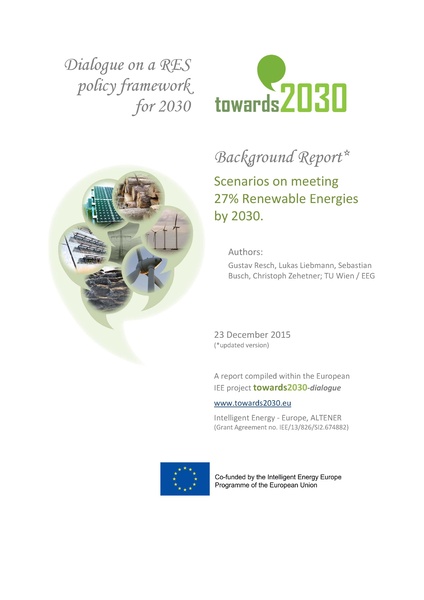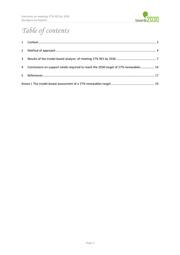File:Scenarios on meeting 27% RES by 2030.pdf
 Size of this JPG preview of this PDF file: 424 × 600 pixels. Other resolution: 170 × 240 pixels. |
Original file (2,480 × 3,508 pixels, file size: 1.35 MB, MIME type: application/pdf, 27 pages)
On 23/24 October 2014 the European Council decided on a new set of targets for 2030 by adopting the “2030 Climate and Energy Policy Framework.” This framework includes binding targets for (i) domestically reducing greenhouse gas emissions by 40% until 2030 compared to 1990 and for (ii) increasing the share of renewables to 27%. Finally, there is an indicative target to improve energy efficiency by at least 27% compared to “business‐ as‐usual” projections of the future energy demand. The framework decided raises several practical questions that need to be addressed in the upcoming legislative process, specifically regarding renewables and the needed support for them. The main issues revolve around the need for dedicated support for reaching the renewables target, the most appropriate policy instruments and pathways for feasible renewables deployment and related costs and benefits. Thus, the aim of this background report is to provide a first quantitative analysis on meeting the 2030 27% RES target, serving as input for the upcoming policy debate and as input for several other work packages and papers within the project. The report will generally discuss the results related to RES deployment and costs like capital costs, support costs and additional generation costs and benefits like avoided fossil fuels and CO2 emissions. The reports “Implementing the EU 2030 Climate and Energy Framework – a closer look at renewables and opportunities for an Energy Union” (Held et al., 2015) and “The EU 2030 Framework for renewables – effective effort sharing through public benchmarks” (Zehetner et al., 2015) are based on the outcomes of the quantitative modelling results presented in this paper. This report starts with an explanation of the applied methodology, a description of the assessed scenarios and an overview of the respective key input parameters, which is then elaborated in further detail in Annex I to this report. This chapter is followed up by the presentation of the quantitative results, including an analysis and comparison of the effects of the various scenarios. In chapter 4 the results and their means regarding the required support needs to reach the 2030 RES target are assessed, and, finally, the report ends with the conclusions drawn from this assessment.
File history
Click on a date/time to view the file as it appeared at that time.
| Date/Time | Thumbnail | Dimensions | User | Comment | |
|---|---|---|---|---|---|
| current | 11:51, 5 February 2016 |  | 2,480 × 3,508, 27 pages (1.35 MB) | ***** (***** | *****) | On 23/24 October 2014 the European Council decided on a new set of targets for 2030 by adopting the “2030 Climate and Energy Policy Framework.” This framework includes binding targets for (i) domestically reducing greenhouse gas emissions by 40% un... |
You cannot overwrite this file.
File usage
There are no pages that use this file.




















